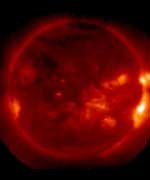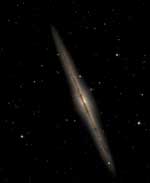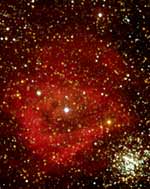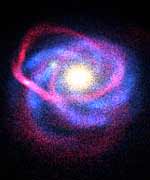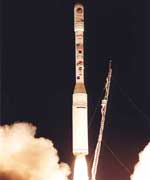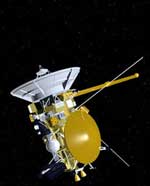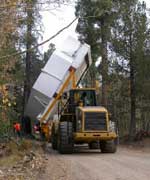
Image credit: UA
The construction of the world’s most powerful optical telescope took a significant step forward this week when the first of its huge mirrors was delivered. The Mount Graham International Observatory’s Large Binocular Telescope will eventually have twin 8.4 metre mirrors linked together, giving it an effective size of 11.8 metres. But the observatory will be able to view extremely faint objects as if it was 22.8 metres across – that’s 10 times the resolving power of the Hubble Space Telescope. The observatory will be completed in 2005.
The world?s most powerful optical telescope, which will allow astronomers to see planets around nearby stars in our galaxy, took a giant step closer to completion late last week when the first of its huge 27-foot diameter mirrors inched up a tortuous mountain road to its new home at Arizona?s Mount Graham International Observatory.
The 18-ton borosilicate “honeycomb” mirror was escorted up the mountain by a team of scientists, engineers, police, and heavy-haul specialists to the Large Binocular Telescope (LBT) facility. The mirror and its all-steel transport box, which together weighed 55 tons, were transported over 122 miles of Interstate and state highway, then up the narrow hairpin turns of the 29-mile Swift Trail to the Mount Graham International Observatory (MGIO) high above Safford, Ariz.
The journey to 10,480-foot-high Emerald Peak was a two-stage, multi-day affair that required five months of intense planning and preparation. This included a full-scale trial run with a dummy mirror in September.
“Everyone is aware that there?s real glass in there this time,” said J.T. Williams as the huge, yellow 48-wheeled transport rig rolled off pavement and onto the gravel road leading to the observatory. Williams, telescope assembly supervisor, walked every inch of the mountain road to inspect the surface and measure the turns during the transport operation.
Precision road grading by MGIO and Arizona Department of Transportation crews smoothed the worst of the washboard stretches of gravel, and haulers soon discovered that the near-vertical mirror load traveled best with a slight increase in speed over the washboard sections.
The mirror?s journey to Mount Graham began on Thursday, Oct. 23, when the Mirror Lab team and workers from Precision Heavy Haul, Inc. (PHH) loaded the mirror transport box and its precious cargo at UA?s Mirror Lab, which is located in the campus football stadium. The mirror-carrying convoy pulled out of the lab hours before dawn on Friday, accompanied by a 25-vehicle police escort that was organized by Mike Thomas of the UA Police Department. The police car-and-motorcycle escort formed a rolling blockade as the mirror rolled down I-10 and State Highway 191. They provided both traffic and mirror safety as the convoy averaged 45 mph to the MGIO base camp at the base of the Pinaleno Mountains.
Last Monday, Oct. 27, the team at base camp transferred the mirror to PHH?s Goldhofer trailer for the three-day, 29-mile journey to the telescope?s home on Emerald Peak. This 8,000-foot climb was made at about one mile per hour.
The Goldhofer trailer rests on six sets of eight wheels. Each wheel set has an independent hydraulic system that allowed the trailer to be accurately leveled, keeping the mirror upright as it negotiated the road?s banked turns.
“This is probably the most challenging job we?ve done,” said PHH President Mike Poppe, who expertly drove the Goldhofer to the telescope. PHH Vice President Jim Mussmann rode on the Goldhofer and monitored hydraulics, constantly adjusting the trailer to maintain the mirror’s center of gravity.
PHH, which is based in Phoenix, hauled the mirror cell (the structure that holds the mirror and its support system) to the LBT a week earlier and transported many other telescope parts to Mount Graham in 2002.
“Arizona was very fortunate to partner with Precision Heavy Haul, a group that wanted to work with the university as a team of one,” said LBT Associate Director Jim Slagle. “The alliance of Arizona scientists and engineers working alongside Precision Heavy Haul on the proper way to bring these pieces up the mountain turned out to be a successful operation.”
Although the mirror was transported to the mountain last week, its journey began back in 1997 when it was spun cast in the Mirror?s Lab?s giant rotating furnace. The Mirror Lab team has been developing new mirror technologies for the past two decades under the direction of UA Regents? Professor J. Roger Angel.
After it was cast, the mirror was polished using the lab?s innovative stressed-lap technique. The face of the deeply parabolic mirror (f/1.14) mirror is precise within a millionth of an inch over its entire surface.
The Mirror Lab is about to begin polishing the LBT?s second 8.4-meter primary mirror.
Work on the LBT began with construction of the telescope building in 1996 and is scheduled to be completed in 2005 when both mirrors are installed at the $100 million facility. The two mirrors together are valued at $22 million. The telescope building is a 16-story structure, the top ten floors of which rotate.
The LBT will have twin 8.4-meter mirrors on a single telescope mount, giving it the light-collecting area of an 11.8-meter (39-foot-diameter) telescope. But what really excites astronomers is that the LBT will make images of even faint objects as sharp as a 22.8-meter (75-foot) telescope would. This is nearly ten times sharper than the images from the Hubble Space Telescope. When the LBT is fully operational, it will be the world?s most powerful optical telescope, capable of imaging planets beyond our solar system. It will allow astronomers to peer deeper into the universe than ever before.
Astronomers won?t have to wait to 2005, however, to begin using the telescope. It will see first light with its first mirror next summer.
The telescope is a compact, stiff and innovative design produced by UA engineer Warren Davison in collaboration with Roger Angel and engineers in Italy. The major mechanical parts for the LBT were fabricated, pre-assembled and tested at the Ansaldo-Camozzi steel works in Milan, one of Italy?s oldest steel manufacturers. Then the telescope was disassembled and shipped by freighter to Houston, Texas, and overland to Safford, Ariz. The Italian-made mirror cell continued to the Mirror Lab, where Integration Team Leader Steve Warner and his team integrated the mirror support system into the cell for final optical tests before PHH hauled the mirror cell to the mountain two weeks ago.
Astronomers were delighted when the mirror reached its home last week.
“I?m both excited and exhausted simultaneously,” said LBT Project Director John M. Hill, who couldn?t be pried away from the mirror after it arrived at the 10,000-foot-high telescope enclosure on Thursday, Oct. 30. “We?ve been working on this mirror for a long time, and it?s great to see it ready to install in the telescope.”
LBT Associate Director Jim Slagle echoed Hill?s enthusiasm. “I?m terrifically excited,” he said. “Today we?re going to have an observatory. For the first time, we have a mirror. We have a mirror cell. And we?re going to have a telescope.”
Steward?s Associate Director Buddy Powell added, “This is a significant milestone in the process to make available the most powerful optical telescope in the world. It would not have been possible without the support of people in Graham County (Arizona), the State of Arizona, Ohio, Italy, and Germany. It is a perfect example of what people from wide and diverse backgrounds can accomplish by working together. We are very proud of their accomplishment.”
Steward Observatory Director Peter Strittmatter said, “Getting the first LBT 8.4-meter mirror to the observatory on Mount Graham is a major accomplishment, and a huge relief. The LBT team and those involved in the transportation are to be congratulated on their achievement. Arizonan?s can take enormous pride in this project.”
The University of Arizona, which also represents Arizona State University and Northern Arizona University on the project, holds a quarter partnership in the LBT. The Instituto Nazionale di Astrofisica, representing observatories in Florence, Bologna, Rome, Padua, Milan and elsewhere in Italy, is also quarter partner in the project. The Ohio State University and the Research Corp. each holds a one-eighth share, with Research Corp. providing participation for the University of Notre Dame, the University of Minnesota, and the University of Virginia. Germany is the fourth quarter partner in LBT, with contributing science institutions in Heidelberg, Potsdam, Munich, and Bonn.
Original Source: UA News Release
